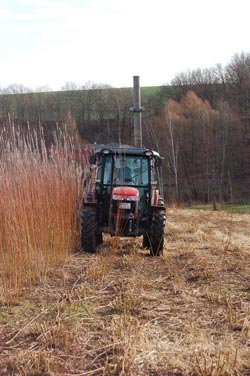Harvesting system for SRC-nurseries in the practical test

Tractor during harvesting in a nursery for willows.<br>Picture: ttz Bremerhaven <br>
To create SRP, it is required to meet several requirements for the planting material of nurseries. Within the EU-funded project “ROD-PICKER”, ttz Bremerhaven and its partners are developing a harvesting system that takes into account these criteria. The field tests of the prototype in real SRPs are scheduled to start next winter.
Harvesting plants is troublesome, especially when it comes to the production of cuttings. The rods required for this purpose have to be cut off, sorted, bundled and then packaged. The EU-funded project “ROD PICKER”, in which ttz Bremerhaven participates as a research partner, is developing a harvesting system to automate this complex process.
After the project partners identified all the necessary requirements and technical components, they have begun with its practical implementation. In February 2014 they’ll send the harvesting system to short rotation fields to perform tests under real conditions.
“It is the multi-functionality, which characterizes the ROD PICKER system. The system is harvesting, sorting, bundling and packaging the rods which will be used for the production of cuttings for SRC. Therefore, the ROD PICKER system is – in comparison to the conventional harvesting methods – much more powerful, “says project manager Bárbara De Mena Pardo of ttz Bremerhaven. The level of automation in conventional methods is usually limited to the cutting off of the rods from the rest of the plant. But with the ROD-PICKER-system the elaborate manual sorting and packing of rods is eliminated.
The ROD – PICKER – harvesting system consists of several subsystems that can be customized and which are combinable in a modular and coordinated way. The subsystems are developed with the close cooperation of all project partners and were developed and technically implemented with a large compatibility to existing harvesting-systems. The system cuts the rods and then sorts them with the help of purpose-oriented camera and sensor technology. The precise sorting process takes into account both the length of the rods, which can be set as desired, as well as possible ramifications, the shape and diameter of the rods. Finally, the rods will be bundled depending on the variety and packaged in boxes.
The 7th The EU Framework Program funded project ROD – PICKER unites six partners from the fields of energy wood use. It started in October 2012 and will run for a period of two years.
ttz Bremerhaven is an independent research institute which conducts applied research and development. Under the roof of ttz Bremerhaven, an international team of experts is working in the fields of food, environment and health. For more than 25 years, it assists companies of all sizes in the planning and implementation of innovation projects and the acquisition of appropriate subsidies on the national and European scale.
Media Contact:
Christian Colmer
Head Communications
ttz Bremerhaven
Fischkai 1
D-27572 Bremerhaven (Germany)
Tel.: +49 (0)471 80934 903
Fax: +49 (0)471 4832 129
ccolmer@ttz-bremerhaven.de
http://www.ttz-bremerhaven.de
http://www.facebook.com/ttzBremerhaven
http://www.twitter.com/ttzBremerhaven
http://www.xing.com/companies/ttzbremerhaven
Media Contact
More Information:
http://www.ttz-bremerhaven.deAll latest news from the category: Agricultural and Forestry Science
Newest articles

Combatting disruptive ‘noise’ in quantum communication
In a significant milestone for quantum communication technology, an experiment has demonstrated how networks can be leveraged to combat disruptive ‘noise’ in quantum communications. The international effort led by researchers…

Stretchable quantum dot display
Intrinsically stretchable quantum dot-based light-emitting diodes achieved record-breaking performance. A team of South Korean scientists led by Professor KIM Dae-Hyeong of the Center for Nanoparticle Research within the Institute for…

Internet can achieve quantum speed with light saved as sound
Researchers at the University of Copenhagen’s Niels Bohr Institute have developed a new way to create quantum memory: A small drum can store data sent with light in its sonic…





















